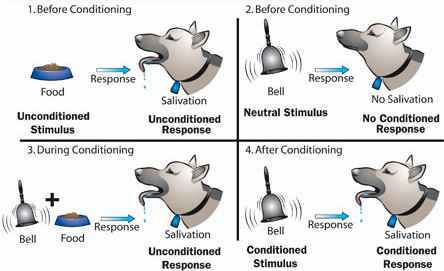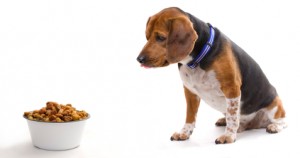The second big thing I (re)learned from Kathy Sdao’s seminar is the importance of the sequencing and contingency required for effective conditioning (or counter conditioning).
In plain English – if you’re trying to get a dog to love something, or get a dog over their fear of something, you can’t screw this up!
Everyone knows about Pavlov and his dogs right? We would be very wise to pay close attention to the following diagram:

Pavlovian Conditioning
In Diagram 3, the bell proceeds the food. That’s how conditioning works – the stimuli is followed by the food, so that in Diagram 4, the bell causes salivation.
If the food were to be delivered before the bell, no conditioning would occur.
Sounds simple right? The emotional qualities and feelings the dog gets with food bleeds backwards into the bell.
Here’s where this simple sequence gets mangled in practical dog training and behavior modification.
Ruining Food as a Reinforcer
What if you were trying to get your dog used to being left home alone as part of separation anxiety work, so you begin by getting out a very special food dispensing toy, take it to the kitchen counter, and take a block of cheese and begin dicing it up and prepping the toy. The dog sees you do this and gets excited. Then, you give the dog the food toy and then proceed to put your shoes on and go out the door.
By going in this order, the food dispensing toy, block of cheese, dicing and prep at the kitchen counter will very quickly become a predictor of something really scary happening – you leaving home. With enough repetitions, your dog might start exhibiting signs of fear and anxiety at the mere sight of the food dispensing toy! That’s because the sequence is all wrong – food, then departure. One of the participants at the seminar remarked that her dog started hiding in fear whenever she brought out a can of dog food and began opening it – because that always meant she was leaving. For this dog, instead of conditioning good feelings around a departure, bad feelings became conditioned around cans of food!
A better way to handle this would be to put your coat and shoes on, get your wallet, keys, and cell phone, and then prepare the food.
Poisoning Cues and Behaviors
If you have a fearful or reactive dog, you can also easily ruin cues and behaviors. If you’ve done work around managing and treating reactivity, you are likely familiar with the “Watch me” protocol, which is to train the dog to look at you when the dog sees the trigger that bothers them (other dogs, strange people, etc.)
Let’s say you are working with a reactive dog and off in the distance, you see a dog approaching but your dog hasn’t spotted it yet. If you cue a behavior (like “Watch me”) and the dog performs it, and gets their click then treat, you may think you have dodged an outburst. But if the dog performs that behavior and then immediately after that, sees the dog, you can easily poison “Watch me” to mean that a dog is coming! Very quickly, you’ll see a dog start panicking and scanning when you cue “Watch me” because you got the sequence wrong.
The only way to handle this is to ensure that the dog sees the trigger first BEFORE you cue “Watch me”. Otherwise, if dogs follow “Watch me”, the fear and anxiety of dogs will bleed backwards into “Watch me” and ruin your cue.

